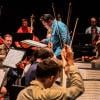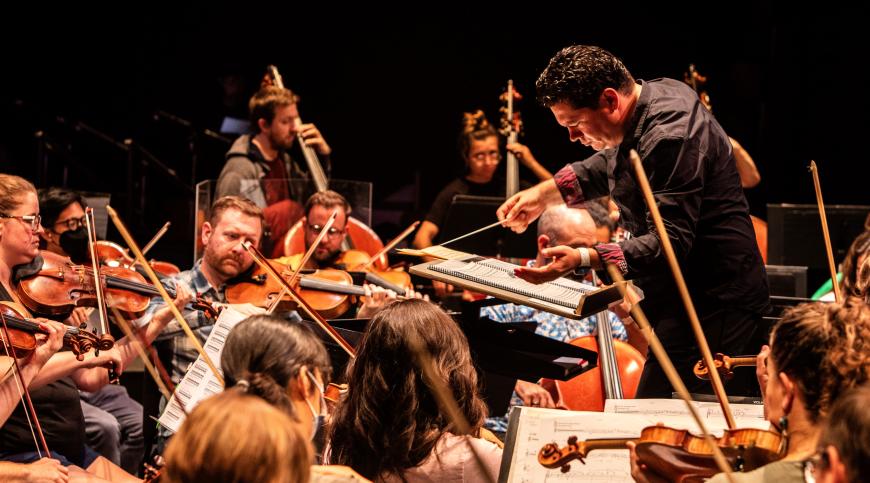
The Cabrillo Festival of Contemporary Music seems too big to fail. The orchestra’s world-class players can and do learn anything. Cristian Măcelaru, music director and conductor since 2017, has a Midas touch. And I’ve never seen such dedicated volunteers, who do everything from ushering to housing the artists. Now, can the programming take some risks?
Of course, orchestras do have to bring the people in, and when big commissions are played in big halls (or basketball stadiums, in the case of the Santa Cruz Civic Auditorium), scope starts to correlate inversely with adventurousness. This isn’t a fault specific to Cabrillo, much of whose programming features compositions funded by other institutions. But if not here, some 60 seasons deep, where?
Over two concerts during the festival’s second weekend, old music came up again and again, most sustainedly in Xavier Foley’s charming, indulgent Resurrection of Titan, a duo concertante for double bass (Foley) and violin (Eunice Kim). It’s a potpourri. Foley loves playing the two Mahler symphonies he references in the work and wants more. The “Frère Jacques” motif in the finale has some fun turns of phrase, and it’s novel to hear the orchestra play in this style. A composer from a previous generation, though, might have contented himself with a transcription. On bass, Foley’s skills are unparalleled; as a composer, let’s hope he comes into his own.
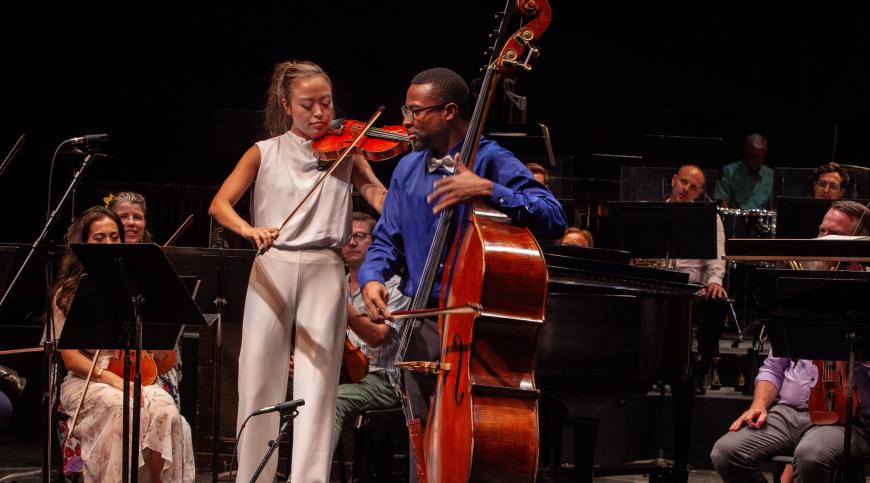
On the other hand, the Pulitzer Prize-winning composer Julia Wolfe is such a giant of the new-music world that I was surprised to learn her music had been featured at Cabrillo only once before. Her idiom is often physically repetitive; riSE and fLY was more than a little strenuous for its soloist Saturday, percussionist Colin Currie. In a punishingly long strain of chest-thumping, Currie, a masterful performer of new music, stopped just a beat to breathe, and the audience cheered him on.
The piece is inspired by New York City street performers. There are buckets, and with them an attitude of “let’s elevate this.” (You decide if it’s patronizing.) When blue notes aren’t enough to make the “groove” section groove, it would be better to invite the street musicians indoors.
Then, more old music: two pieces by the late Robert Hughes. The local multi-hyphenate was a Cabrillo co-founder, yet the festival hasn’t much featured his music since the early days. And Estampie, arranged for full orchestra in 1979 but initially conceived in 1961, is music of another time, when composers like Lou Harrison, with whom Hughes studied, breathlessly imitated the music of different cultures. The tricks here don’t quite hold up.
I would have liked to hear Hughes talk about Uutiqtut. Three chords brace; then, there’s an onslaught. A lurching gigue somehow recalls both Dmitri Shostakovich and Tchaikovsky’s Fourth Symphony; elsewhere, there’s a lilting gymnopédie. There are plenty of surfaces to inspect, but it was the least burnished material of the weekend.
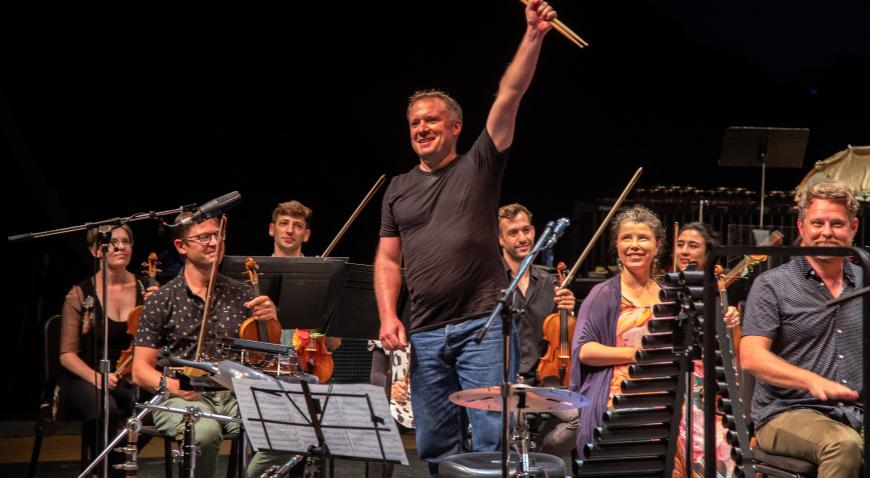
Two short works, by Gabriella Smith and Olga Neuwirth, were more self-assured. Smith’s complicated-sounding f(x)=sin²x-1/x is really just a couple of crescendos — “if you don’t want to think about the math,” the composer said.
If you’ve heard any of Smith’s music, it’s easy to spot the trail markers here: propulsive, semi-pitched rhythms via modestly extended string techniques, oscillations of harmonics like the calls of whales, and slow glissandos that climb to glacial expanses. Tighter pacing and a new jazziness in the winds and brass make this an upgrade to her 2014 Cabrillo work Tumblebird Contrails. Still, she’s ready to explore some new territory.
In Neuwirth’s Dreydl, cyclical rhythms spin Boléro-like melodies round and round. It’s one schtick, but a good one: fair enough, given that only four things can ever happen in dreidel. With a lesser orchestra it’d be hey (“take half”); under Măcelaru, it shuddered down on gimel, the jackpot.
Neuwirth, 55, was born in Austria; this is the first time her music has been programmed at the festival. I’d like to hear more from two additional first-timers at Cabrillo: Gabriela Ortiz and Dan Caputo, each of whom contributed sprawling, dreamlike works.
Ortiz’s TZAM is a tribute to three people she lost — her father, her teacher, and her mentor — but this is no elegy. Spangling brass licks unfold into bold cinematic landscapes (like Erich Wolfgang Korngold, or Samuel Barber if he wrote film music). One gets the sense that the three departed ones were big personalities.
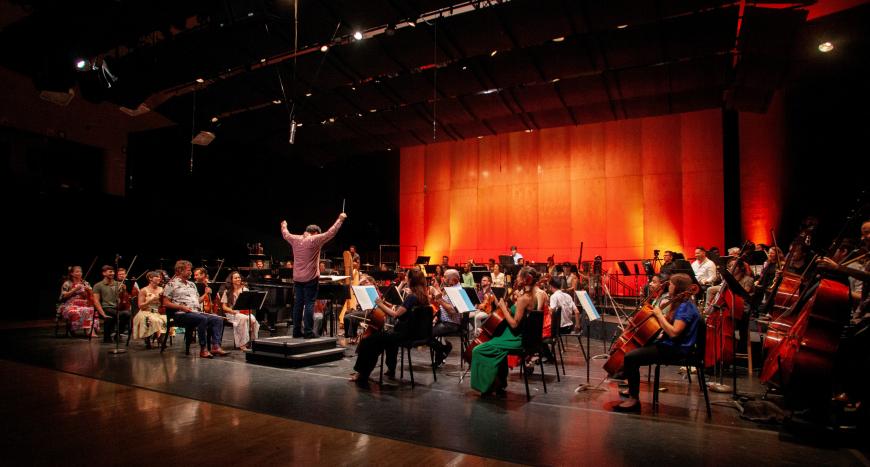
Tzam, in the indigenous language of Ayapaneco, means “dialogue.” Fittingly for a language that has fewer than a dozen speakers and will soon die, the dialogue is with memories. The lower strings’ ever-so-slightly displaced undulations echo on and on. The calls of antiphonally seated trumpets are like variations on an ancient story. (This moment defined the space with greater emotional impact than did the electronics of Anna Clyne’s new commission Wild Geese on the next night’s program.) When the opening strain of Ortiz’s work returns, it sounds pasted on, as if trying to hide the signs of its tears.
Liminal, by the Los Angeles-based Caputo, sumptuously depicts insomnia. The orchestra wheezes. Solos flash, like involuntary thoughts, against the effortful equanimity of opaque chords. Then, a blink, and we’re asleep. Gravity no longer a constraint, the harmonies climb, and the melodies fill with Fauvist color. Like all good dreams, it slips away too soon.
It was the most ambitious and well-crafted piece of the festival, Kevin Puts’s Concerto for Orchestra, that typified the Cabrillo aesthetic.
Puts, another Pulitzer winner, can also claim the award for most ubiquitous. In the last 20 years, his music has appeared at Cabrillo 14 times. In these exuberant neoclassical miniatures, the orchestration sings, the phrases are taut. It was gratifying to see the players highlighted, particularly the principal winds and concertmaster Justin Bruns.
But Concerto for Orchestra doesn’t interact with its predecessors in a thought-provoking way. Puts spoke of the monumental Béla Bartók work of the same name, but this music is lighter fare, more like Benjamin Britten’s The Young Person’s Guide to the Orchestra. And we already have that piece.
Really, nothing this weekend was much more than blandly palatable. Most of it wasn’t even emotional. It’s summer — people want a good time, maybe — but shouldn’t the birth of new art be a revolutionary act, one that forces the reordering of everything that’s come before? Or at least keeps Santa Cruz weird?



